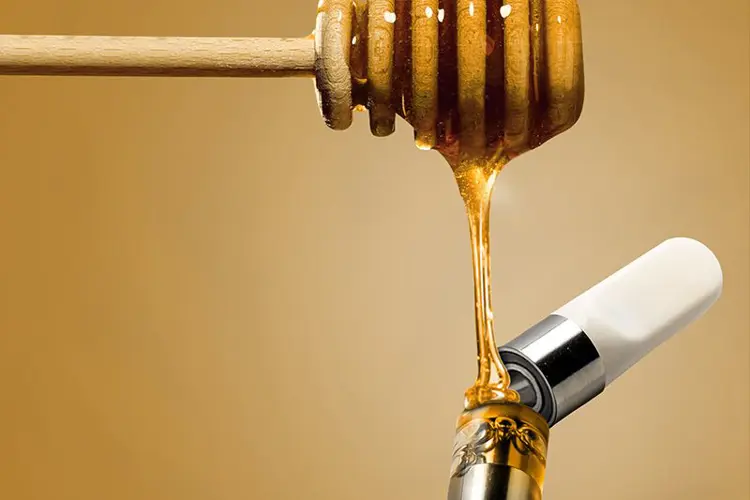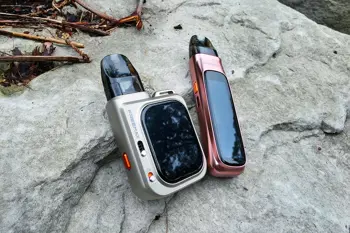No weed vaper wants to deal with a hit that falls flat. But identifying the cause behind a clogged vape cart can be challenging. Thicker oils are not easy to vaporize, weed pens are often not set up properly, and not every cart-producing company has stellar quality control.
On the positive side, THC, CBD, or delta 8 cart clogs are often preventable. Our goal with this guide is to provide a one-stop toolbox for unclogging your cartridge, whether there’s limited airflow or a lack of vapor. We’ll also offer some tips and tricks to help you optimize the maintenance of your vape carts. That way, you can stop disaster before it rears its head!
Your choice of oil matters
Let’s start with one of the fundamentals. The likelihood that your vape gets clogged depends, in part, on the vape oil you’re using. This pertains to both the type and the quality of your oil.
Types of oil and clogging
Different kinds of cannabis oils have varying consistencies, and some are more prone to clogging.
For instance, live resin sauces are potent, viscous oils. This can make these oils harder to vaporize. It’s also possible that cannabinoids in this form will separate and crystallize, which can cause your vape cart to clog. Isolate-based formulations also tend to crystallize, so they are prone to the occasional clog as well.
If you’re worried about clogging, distillates tend to be the lower-risk option. This doesn’t mean that vapers should avoid resin or isolate-based products, however. Every type of oil has unique qualities and can be used in a way that minimizes the risk of clogging. It’s simply a good idea to keep the risks in mind and take the proper precautions, as we’ll discuss later.
Not all vape carts are of good quality
While the type of oil you select comes down to personal preference, that shouldn’t be the case with quality. It’s wise for all vape users to favor high-quality carts (as well as batteries) from reputable sellers.
Black-market cannabis oil isn’t going to do your cart any favors. While reputable online sellers and dispensaries have quality and safety standards to uphold, knockoff sellers only want to profit from a cheap product.
Sticking to trusted, thoroughly tested products may not lead to a clog-free vape experience. But some clogging may be due to the lack of quality control, low-quality materials, and mix-n-matching between incompatible products (the wrong cart for the oil, the wrong battery for the cart, and so on). All that can be avoided by going the extra mile when shopping online.
However, if you follow those guidelines and still have problems, we can tell you how to fix a clogged vape cartridge.
Why is my new cart not hitting?
Fresh out of the box, it’s fair to expect your THC or CBD cart to perform at its peak. That isn’t always what happens. If your new cart isn’t producing any vapor, here’s what you should check.
Is the device working properly?
Before all else, you’ll need to figure out which area needs troubleshooting. It’s always possible that the problem lies in your battery rather than the new cart.
Make sure that your battery is fully charged and swap out your THC or CBD cart, ideally for one of another brand. If you’re still struggling to take a hit, you’ve found the root of your predicament—a battery issue. Take note of the indicator light. A flashing light usually points to an error, and it’s time to consult the device’s instruction manual.
If the second cart hits well, the problem with the first one could be a poor electrical connection in the atomizer or a broken coil. If this is the case, you’re out of luck unless the retailer that sold it will exchange or refund it.
Check for leftover oil from a past leak
Residual liquid in the 510 connection of your battery could be the culprit. You’ll need to remove your cart to get a better look at the threading of your battery. If you see leftover oil from another cart, this may be hampering the connection between your device and the brand-new THC, CBD, or delta 8 cart.
Fortunately, leaks like this are usually simple to tidy up. All you’ll need is a cotton swab and isopropyl alcohol. Using this household chemical, it’s possible to gently dissolve the cannabis oil stuck to the threading.
Depending on the amount of oil, it may take more than one swab to completely clean it out. After the oil is gone, you can mop the leftover alcohol with a dry swab or let your device air dry.
Warm up the oil
Some cannabis oils have more trouble absorbing into a wick or a ceramic coil than others. This is especially true for oils that are highly viscous at room temperature.
When using a THC or CBD oil cart for the first time, you may need to manually warm the oil to help it get absorbed. One way to accomplish this is to secure your cart in a plastic bag and allow warm water to run over it for a few minutes.
How to unclog a vape pen cartridge with no airflow
Whether your cart is new or old, a sudden lack of airflow can be frustrating. Here are some of the best ways to troubleshoot the issue.
Check your cart’s airflow setting
Not every vape cart is designed the same. The way you adjust the airflow may vary between carts, and there’s always a chance your airflow is just shut Sometimes the cart draws air from the bottom, next to the threads. If you have a new vape cartridge with no airflow, try slightly loosening the cart to see if this improves the airflow.
Condensation buildup and lack of airflow
Once you’re certain that the issue isn’t fixed by a simple airflow adjustment, you can begin to target the blockage. One of the most common reasons for blockage is condensation buildup.
As the name suggests, this refers to excess condensation building up in your cartridge’s airway. A high amount of condensation can lead to the airways of the cart becoming blocked, preventing vapor from passing through.
When you take a hit and end up with drops of oil in your mouth, chances are, condensation buildup is the cause.
Thankfully, blockages due to condensation buildup are usually simple to fix. Start by removing the cart from the battery and using the lowest setting of a hair dryer to warm it up a bit and reduce the viscosity of the oil. (Or you could use the warm water trick we described above.)
Once the cart has warmed up, it’s time to clear out any oil currently sitting in the mouthpiece. Try using something sturdy and thin, such as a paperclip or pin. Use this object to manually scrape residue from within the mouthpiece. (Avoid scraping too aggressively, as this could cause scratching or damage. Don’t push the object so far inside that it damages the atomizer.)
Then use the same object to scrape any oil that has accumulated between the connection of the cart and the battery. The Q-tip and rubbing alcohol combo can also help here.
To test the results, reassemble your vape and inhale on the mouthpiece to see if air can pass through the cart.
Chamber flooding
A flooded chamber can occur when a vape is left to sit, without use, for extended periods of time. Cannabis oils are viscous at room temperature. When this thick oil stays on the base of the cartridge for a long time, the wick or ceramic coil may not be able to keep it in check, which leads to a flood. Signs of flooding include gurgling sounds and thin or sparse vapor.
It’s often possible to unclog a flooded cart and get your vape back to working order.
You can start by dislodging as much of the oil as possible from the drowned coil. Try tipping the cart from side to side and upside down, freeing the excess oil and allowing it to disperse evenly.
From here, the goal should be to clear out oil from the chamber. Never inhale as a way to pull out oil. All this will do is move even more liquid into the chamber and flood it further.
When unclogging a pre-filled cart, blowing is your best bet. Turn the cart upside down (mouthpiece facing the floor) and gently blow in the mouthpiece.
But if you are using a refillable cart, it’s usually more productive to disassemble it and manually take care of the flooding. In most cases, you’ll be able to detach the chamber and gently remove any excess oil. Then, reassemble the cart.
Test the vape by firing it up and blowing. Stay away from inhaling until you’re sure that the flood has been fixed. You’ll only need a couple of seconds to vaporize the liquid you’ve dislodged.
Intervene early
The earlier you intervene, the quicker and easier the clog will be to resolve. Periodically cleaning your mouthpiece is a good habit to develop, even before there’s any noticeable buildup.
What to do when a cart has airflow, but no vapor
Most of the issues described above can also cause a lack of vapor; oil leaking into the connection between the cart and the battery may prevent the device from firing, and this may be caused by condensation or a flooded chamber. But the most common culprit is the battery itself.
When you purchase your cart from a reputable manufacturer, they often provide setting recommendations. Take a look at the manual or website to see if your device has been set up correctly.
Certain devices allow manual wattage/voltage adjustments, for instance. If your current setting is beneath the manufacturer’s recommendation, the device may not be providing enough power to vaporize the oil. On the other hand, if it’s set too high, it can scorch the oil.
How to prevent cart clogs before they occur
If you want to uphold the health of your cart, prevention is key. Developing the right habits can keep your cartridge free of clogs, condensation buildup, or chamber flooding.
Proper storage can prevent vape clogs
When your THC, CBD, or delta 8 cart isn’t in use, keep it disconnected from a device. This will prevent oil from finding its way to your battery’s connection. Also, be sure to store your cart upright, with the mouthpiece facing up.
Properly storing your vape cart can prevent the oil from leaking and reduce the clogging risk. Proper cart storage is especially vital if you plan to go long stretches of time without taking a hit (more than a week or so), which would give liquid more time to leak into places it doesn’t belong.
Favor shorter hits
A good rule of thumb is to keep your hits short—under three seconds. Long, aggressive hits can overwhelm the coil and wick, as thick oils are not easy to vaporize. When you do this regularly, you’re boosting your risk of buildup and an undersaturated coil.
Periodically pulling on the cart without firing up can also help. Be sure to keep these hits brief, just like your regular puffs, or you could flood the cart.
Clean excess oil from the mouthpiece
Prior to any noticeable buildup, go in and clean up the inside of your mouthpiece.
Give your mouthpiece a quick wipe with a cotton swab every now and again. Clearing out this small amount of excess oil can prevent a future buildup.
Lessen clogs with regular vape use
If you needed a sign to pull out your vape more often, this is it! No matter how you store your cart, letting it sit in your drawer can increase the frequency of floods and clogs.
Vaping every couple of days gives the cart less time to sit and develop a flood. Regular vape use ensures that the excess oil is cleared out, rather than drowning the coil.
Cannabis oil clogs aren’t the end of your cart
As frustrating as a clogged cart can be, it’s often possible to take care of the issue without much hassle. Plus, regular maintenance and proper storage can greatly reduce your clog risk. The next time you’re dealing with a flooded chamber or excess condensation, just return to this guide. We’ve got your back!
President Trump promised during his election campaign to “save vaping," but his administration has undermined that goal at every turn.
The U.S. disposable vape market has grown to $2 billion in annual sales, although nearly none of the products are authorized by the FDA.
More than 30 bills that would impose severe restrictions vaping consumers’ product choices remain active in U.S. state legislatures.
The Freemax REXA PRO and REXA SMART are highly advanced pod vapes, offering seemingly endless features, beautiful touchscreens, and new DUOMAX pods.
The OXVA XLIM Pro 2 DNA is powered by a custom-made Evolv DNA chipset, offering a Replay function and dry hit protection. Read our review to find out more.
The SKE Bar is a 2 mL replaceable pod vape with a 500 mAh battery, a 1.2-ohm mesh coil, and 35 flavors to choose from in 2% nicotine.






















